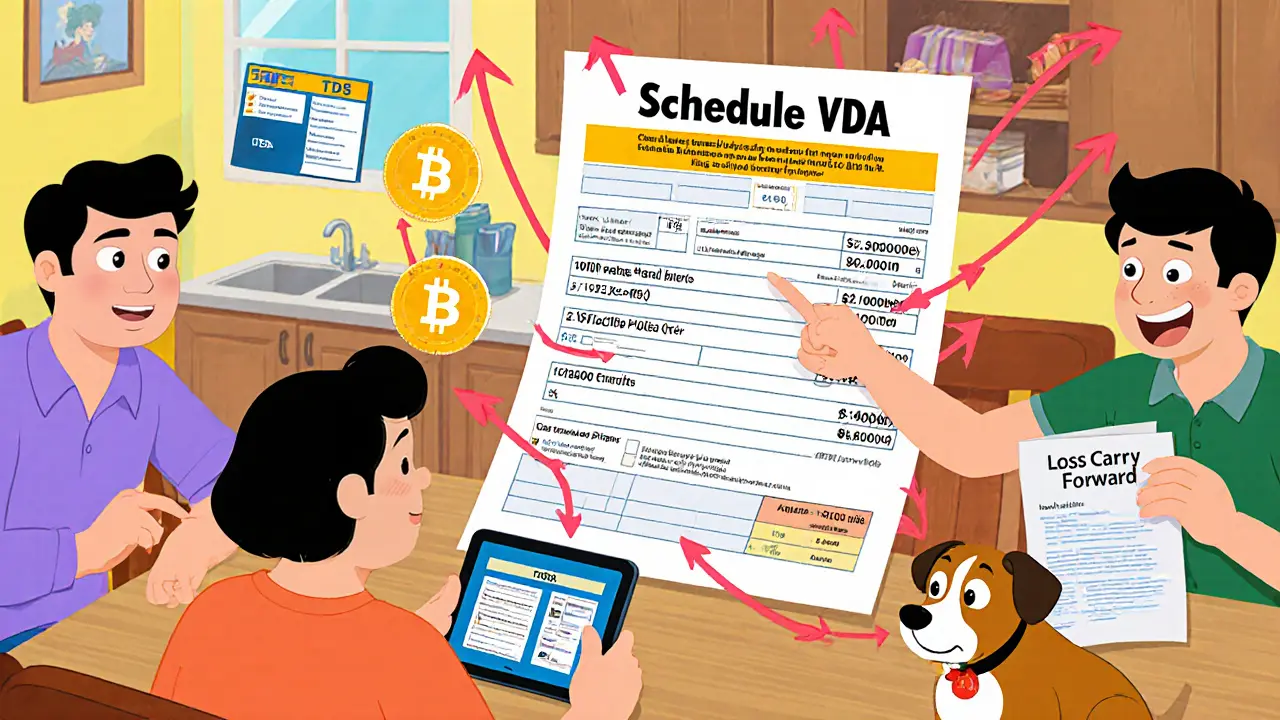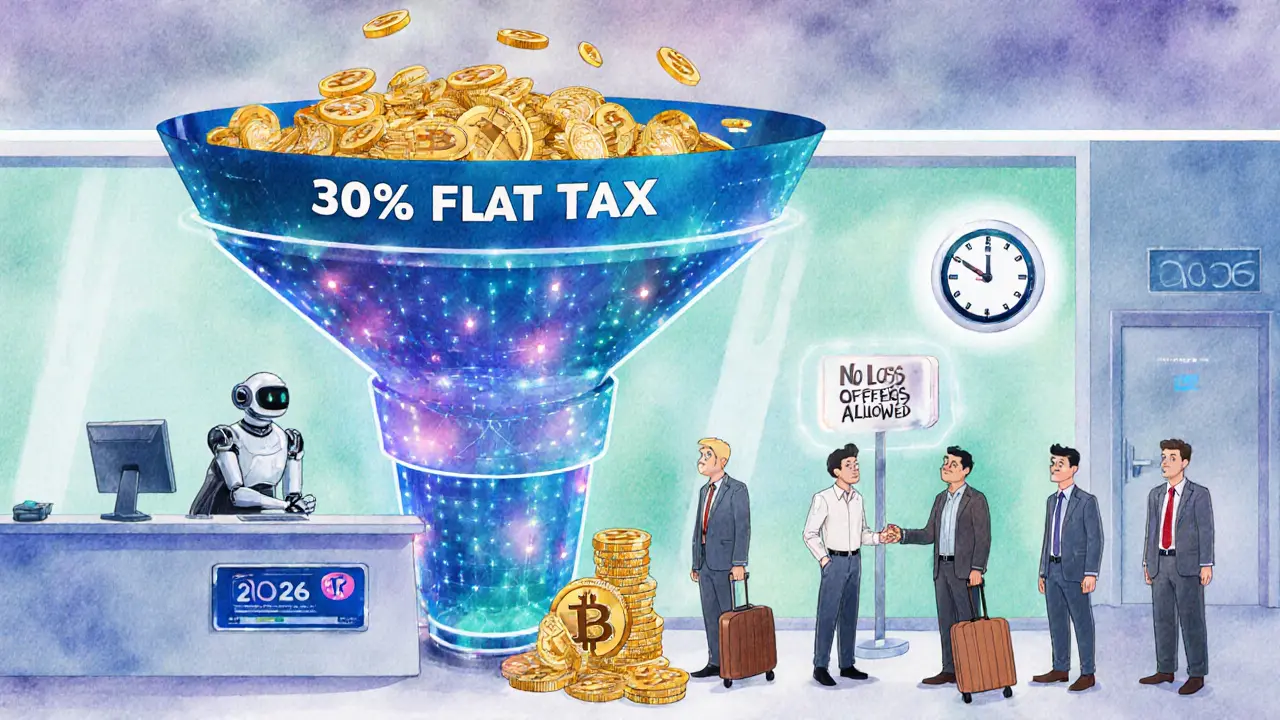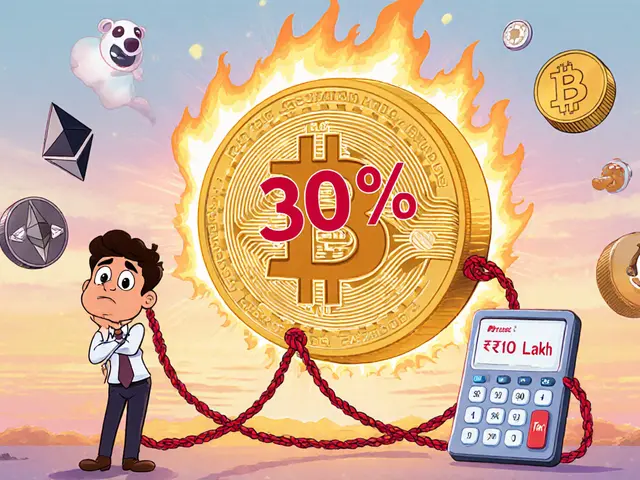VDA Tax Calculator
Calculate Your Crypto Tax Liability
Tax Calculation Results
Transaction Summary
Asset:
Profit:
30% Tax:
1% TDS (if applicable):
Total Tax Liability:
India's VDA Tax Rules:
• 30% tax on all gains
• 1% TDS on transactions over ₹10,000
• No loss offsets against other income
Important: This calculator uses India's current VDA tax rules effective from 2025. Losses from VDAs can only offset future VDA gains and must be used within 8 years.
India’s rules for taxing Virtual Digital Assets (VDAs) are some of the strictest in the world. If you’re buying, selling, or holding Bitcoin, Ethereum, NFTs, or any other digital token, you need to know exactly how the tax system works-because mistakes can cost you big time. Unlike traditional investments, there are no deductions, no loss offsets, and no benefit from holding long-term. The system is simple, but harsh. And it’s not changing anytime soon.
What Counts as a Virtual Digital Asset?
Under Section 2(47A) of the Income Tax Act, a Virtual Digital Asset includes anything that represents value digitally and is traded using cryptography. That means Bitcoin, Ethereum, Solana, Dogecoin, NFTs, and even tokens from decentralized finance (DeFi) platforms all fall under this category. What doesn’t count? Indian rupees, foreign currencies, and physical gold or silver. The government made this definition broad on purpose-so nothing slips through the cracks.
Even swapping one crypto for another counts as a taxable event. If you trade 0.5 BTC for 10 ETH, that’s not a simple exchange-it’s a sale of BTC and a purchase of ETH. Both sides of the trade are taxed at 30% on the profit you made.
The 30% Tax Rate: No Exceptions
Here’s the brutal truth: all gains from VDAs are taxed at a flat 30%, no matter your income level. Even if you’re in the 5% tax slab, your crypto profits get hit with 30%. And there’s no indexation benefit. In the past, if you held stocks or real estate for more than two years, you could adjust your purchase price for inflation. That’s gone for crypto. You pay 30% on the full difference between what you paid and what you sold for.
And here’s what you can’t deduct: transaction fees, gas fees, mining costs, wallet fees, or even the cost of buying a hardware wallet. Only the original purchase price of the asset itself counts as a cost of acquisition. Everything else? Gone. So if you bought 1 BTC for ₹30 lakh and sold it for ₹40 lakh, your taxable gain is ₹10 lakh. Even if you paid ₹50,000 in network fees over the year, that doesn’t reduce your tax bill.
Losses Can’t Offset Anything
This is where most investors get blindsided. If you lose money on crypto, you can’t use that loss to reduce your salary tax, your business income, or even gains from stocks or real estate. The law says losses from VDAs can only be used to offset future gains from other VDAs-and even then, only for eight years.
Let’s say you bought Ethereum in 2022 for ₹8 lakh and sold it in 2023 for ₹4 lakh. You lost ₹4 lakh. That loss stays locked in the VDA bucket. You can’t use it to lower your ₹15 lakh salary tax. If you make ₹6 lakh in crypto gains in 2025, you can use ₹4 lakh of your old loss to reduce that gain to ₹2 lakh. But if you never make another crypto profit, that ₹4 lakh loss disappears after eight years. No refund. No carryover to other assets. Just gone.
TDS at 1%: The Hidden Tax
On top of the 30% tax, there’s a 1% Tax Deducted at Source (TDS) on every VDA transaction over ₹10,000 in a financial year. For specified persons-like those with business income under ₹1 crore or professional income under ₹50 lakh-the threshold is ₹50,000. Exchanges like WazirX, CoinDCX, and ZebPay automatically deduct this when you sell or trade.
Here’s the catch: this TDS is not your final tax. It’s just an advance payment. You still have to file your return and pay any additional tax if your 30% liability is higher than what was deducted. If you didn’t give your PAN, the TDS jumps to 20%-a massive penalty for a paperwork oversight.
Many users report errors in TDS calculations. Trustpilot data from Q2 2024 shows 62% of tax complaints on Indian exchanges involve over-deduction-sometimes by 15-22%. If you’re seeing more TDS taken than your actual profit, you’ll get it back when you file your return. But you’ll have to wait until next year’s tax season to see that refund.

How to Report VDA Transactions
You must report all VDA transactions in Schedule VDA of your income tax return. This applies to ITR-2 or ITR-3 forms. You need to list:
- Asset name (e.g., Bitcoin, NFT #1234)
- Date of acquisition
- Date of transfer
- Cost of acquisition (in INR at the time of purchase)
- Full value of consideration (in INR at the time of sale)
- Any TDS deducted
For crypto-to-crypto trades, you must convert both sides to INR using exchange rates from government-approved platforms like CoinDCX or WazirX. The CBDT doesn’t accept CoinGecko or CoinMarketCap for this purpose. If you use the wrong rate, you risk a notice.
Keep blockchain records. Screenshots of your wallet transactions, transaction IDs, and exchange statements are mandatory. According to NISM, 65% of tax disputes in FY2023-24 happened because people couldn’t prove their purchase price or transfer dates.
What About Mining and Staking?
Income from mining or staking is treated as business income. That means it’s taxed at your regular slab rate (up to 30% plus cess). When you later sell those mined coins, you pay another 30% on the gain from the time you received them. So you’re taxed twice: once on the income value when you received the coins, and again when you sell them.
Example: You mine 0.1 BTC in January 2024 when it’s worth ₹3.5 lakh. You report ₹3.5 lakh as business income. In June 2024, you sell it for ₹4 lakh. Now you pay 30% tax on the ₹50,000 gain. That’s ₹15,000 extra. Total tax on that 0.1 BTC? ₹1.05 lakh (30% of ₹3.5 lakh) + ₹15,000 = ₹1.2 lakh. That’s 34.3% total tax on the original ₹3.5 lakh value.
How This Compares to Other Countries
India’s system is extreme. In Portugal, crypto gains are tax-free for individuals. In Singapore, you only pay tax if you’re trading crypto as a business. In Germany, you pay zero tax if you hold for over a year. In the U.S., long-term gains are taxed at 0%, 15%, or 20% depending on income-with losses able to offset other gains.
India’s 30% flat rate with no loss offsets is rare. Only a few countries like France and Belgium have similar structures, but even they allow some deductions. India’s 1% TDS is also unusually high. The EU’s upcoming DAC8 rule proposes 0% TDS for crypto. Japan taxes crypto as miscellaneous income at up to 55%. India’s system is simpler than Japan’s, but far harsher than most.
What Experts Are Saying
There’s no middle ground in expert opinions. Dr. S. Rajeesh from Kerala University says the system saved ₹3,920 crore in FY2023-24-27% more than expected. The simplicity cut compliance time by 60-70% for most taxpayers.
But Pankaj Nahta of Tax2Win says the 30% rate makes crypto unviable for anyone except speculators. He points out that after tax, even a 45% annual return on crypto barely beats a fixed deposit. KPMG’s 2023 survey found 68% of institutional investors cut their Indian crypto exposure by half. BlackRock’s India head said the tax structure makes India non-competitive for global crypto funds-costing $2.1-3.4 billion in potential investment each year.

Real Investor Stories
On Reddit, user ‘CryptoSaverIN’ lost ₹2.87 lakh on Ethereum in 2023 but couldn’t use the loss to reduce his ₹12 lakh salary tax. He called it “financially punitive.”
Another user, ‘NiftyGainer’, found a loophole: converting crypto to Bitcoin ETFs before year-end. Since ETFs are taxed as securities (not VDAs), he got 3.2% higher net returns. He’s not alone. WalletInvestor’s 2024 survey found 44% of Indian traders now gift crypto to family members in lower tax brackets to reduce liability.
Professional traders, though, like ‘TaxWiseTrader’ on TradingQ&A, praise the clarity. “No more guessing if it’s capital gain or business income,” he said. “30% flat? I know exactly what I owe.”
What’s New in 2025?
The Income Tax Act, 2025, passed in August 2025, didn’t change the 30% rate-but it did make enforcement digital-first. The assessment year is now called “Tax Year,” and specialized dispute cells are being set up. The government is also reviewing a new Virtual Asset Service Providers Bill, which could require licenses for exchanges and wallet providers. If passed, this might add another layer of compliance.
ICRA predicts VDA tax revenue will hit ₹9,200 crore by FY2025-26. CRISIL warns that without changes, 12-18% of users may move to offshore platforms by 2026. But EY India believes compliance will hit 70%+ by 2027 as people adapt.
What You Should Do Now
1. Track every transaction-buy, sell, swap, stake, mine. Use a crypto tax tool like Koinly or CoinTracker, and export your data in CSV.
2. Save proof of purchase-screenshots of wallet addresses, transaction IDs, and exchange receipts. Don’t rely on exchange statements alone.
3. Calculate your cost basis correctly. Only the INR value at purchase counts. Ignore fees.
4. Check your TDS. If your exchange deducted more than your actual profit, you’ll get it back-but only if you file correctly.
5. Use ITR-2 or ITR-3. Don’t file ITR-1. You’ll get a notice.
6. Don’t gift crypto to strangers. The tax department tracks large transfers. Gifting to immediate family is fine, but document it.
7. Use CBDT’s TaxAssist VDA chatbot. It answers 12,000+ questions daily and can clarify how to report a specific trade.
Final Reality Check
India’s VDA tax system isn’t designed to encourage crypto. It’s designed to capture revenue from a market that exploded overnight. It’s not fair. It’s not balanced. But it’s the law.
If you’re holding crypto in India, you’re paying more in taxes than in almost any other country. But if you’re still trading, you’re betting that the returns will outweigh the tax hit. That’s a gamble. And right now, the house has the edge.
Know your numbers. Keep your records. File on time. And don’t expect the rules to get easier.
Is crypto taxed in India?
Yes. All gains from Virtual Digital Assets-including Bitcoin, Ethereum, NFTs, and other tokens-are taxed at a flat 30% under Section 115BBH of the Income Tax Act. This applies whether you hold the asset for one day or five years.
Can I offset crypto losses against my salary?
No. Losses from Virtual Digital Assets can only be used to offset future gains from other VDAs. They cannot reduce income from salary, business, or other investments. If you don’t make another crypto profit within eight years, the loss disappears.
What is the 1% TDS on crypto?
A 1% Tax Deducted at Source is automatically withheld by exchanges on every VDA transaction exceeding ₹10,000 in a financial year (₹50,000 for specified persons). This is an advance tax payment, not your final tax. You still need to calculate your 30% liability and pay any difference when filing your return.
Do I pay tax on crypto-to-crypto trades?
Yes. Swapping one cryptocurrency for another is treated as a sale of the first asset and a purchase of the second. You must calculate the profit in INR at the time of the swap and pay 30% tax on it. Use exchange rates from government-approved platforms like CoinDCX or WazirX for valuation.
Can I use losses from stocks to reduce crypto tax?
No. Losses from stocks, real estate, or any other asset class cannot be used to reduce your VDA tax liability. The law treats crypto losses as isolated to the VDA category only.
What documents do I need for crypto tax filing?
You need: (1) Transaction history from exchanges, (2) Wallet addresses with timestamps, (3) Proof of acquisition cost in INR (screenshots of purchase receipts), (4) TDS certificates (Form 26QE), and (5) Records of any crypto-to-crypto trades. Without these, you risk a tax notice.
Is staking income taxable?
Yes. Rewards from staking or mining are treated as business income and taxed at your regular income tax slab rate. When you later sell those tokens, you pay another 30% on the gain from the time you received them.
What happens if I don’t report crypto income?
The Income Tax Department receives transaction data directly from exchanges. If you don’t report, you’ll get a notice. Penalties can include 50-200% of the tax evaded, plus interest. In serious cases, the department may initiate prosecution under the Income Tax Act.
Are NFTs taxed the same as Bitcoin?
Yes. NFTs are classified as Virtual Digital Assets under Indian law. Any profit from buying or selling an NFT is taxed at 30%. The same rules for cost of acquisition, TDS, and loss carryforward apply.
Will crypto tax rules change in 2026?
There are no official plans to change the 30% rate or loss rules in 2026. However, the government is reviewing the Virtual Asset Service Providers Bill, which could add licensing requirements for exchanges. Any changes would likely focus on enforcement, not tax relief.





